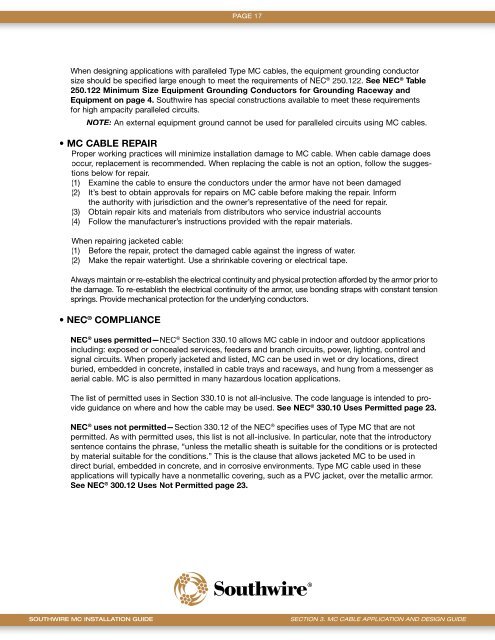MEGA MC Cable Installation & Application Guide - Southwire
MEGA MC Cable Installation & Application Guide - Southwire
MEGA MC Cable Installation & Application Guide - Southwire
You also want an ePaper? Increase the reach of your titles
YUMPU automatically turns print PDFs into web optimized ePapers that Google loves.
page 17<br />
When designing applications with paralleled Type <strong>MC</strong> cables, the equipment grounding conductor<br />
size should be specified large enough to meet the requirements of NEC ® 250.122. see neC ® table t<br />
250.122 Minimum size equipment grounding Conductors for grounding Raceway and<br />
equipment on page 4. <strong>Southwire</strong> has special constructions available to meet these requirements<br />
for high ampacity paralleled circuits.<br />
NOTE: An external equipment ground cannot be used for paralleled circuits using <strong>MC</strong> cables.<br />
• <strong>MC</strong> <strong>Cable</strong> RepaiR<br />
Proper working practices will minimize installation damage to <strong>MC</strong> cable. When cable damage does<br />
occur, replacement is recommended. When replacing the cable is not an option, follow the suggestions<br />
below for repair.<br />
(1) Examine the cable to ensure the conductors under the armor have not been damaged<br />
(2) It’s best to obtain approvals for repairs on <strong>MC</strong> cable before making the repair. Inform<br />
the authority with jurisdiction and the owner’s representative of the need for repair.<br />
(3) Obtain repair kits and materials from distributors who service industrial accounts<br />
(4) Follow the manufacturer’s instructions provided with the repair materials.<br />
When repairing jacketed cable:<br />
(1) Before the repair, protect the damaged cable against the ingress of water.<br />
(2) Make the repair watertight. Use a shrinkable covering or electrical tape.<br />
Always maintain or re-establish the electrical continuity and physical protection afforded by the armor prior to<br />
the damage. To re-establish the electrical continuity of the armor, use bonding straps with constant tension<br />
springs. Provide mechanical protection for the underlying conductors.<br />
• neC ® CoMplianCe<br />
neC ® uses permitted—NEC ® Section 330.10 allows <strong>MC</strong> cable in indoor and outdoor applications<br />
including: exposed or concealed services, feeders and branch circuits, power, lighting, control and<br />
signal circuits. When properly jacketed and listed, <strong>MC</strong> can be used in wet or dry locations, direct<br />
buried, embedded in concrete, installed in cable trays and raceways, and hung from a messenger as<br />
aerial cable. <strong>MC</strong> is also permitted in many hazardous location applications.<br />
The list of permitted uses in Section 330.10 is not all-inclusive. The code language is intended to provide<br />
guidance on where and how the cable may be used. see neC ® 330.10 uses permitted page 23.<br />
neC ® uses not permitted—Section 330.12 of the NEC ® specifies uses of Type <strong>MC</strong> that are not<br />
permitted. As with permitted uses, this list is not all-inclusive. In particular, note that the introductory<br />
sentence contains the phrase, “unless the metallic sheath is suitable for the conditions or is protected<br />
by material suitable for the conditions.” This is the clause that allows jacketed <strong>MC</strong> to be used in<br />
direct burial, embedded in concrete, and in corrosive environments. Type <strong>MC</strong> cable used in these<br />
applications will typically have a nonmetallic covering, such as a PVC jacket, over the metallic armor.<br />
see neC ® 300.12 uses not permitted page 23.<br />
<strong>Southwire</strong> <strong>MC</strong> inStallation <strong>Guide</strong> section 3. Mc cAble ApplicAtion And desiGn GUide



